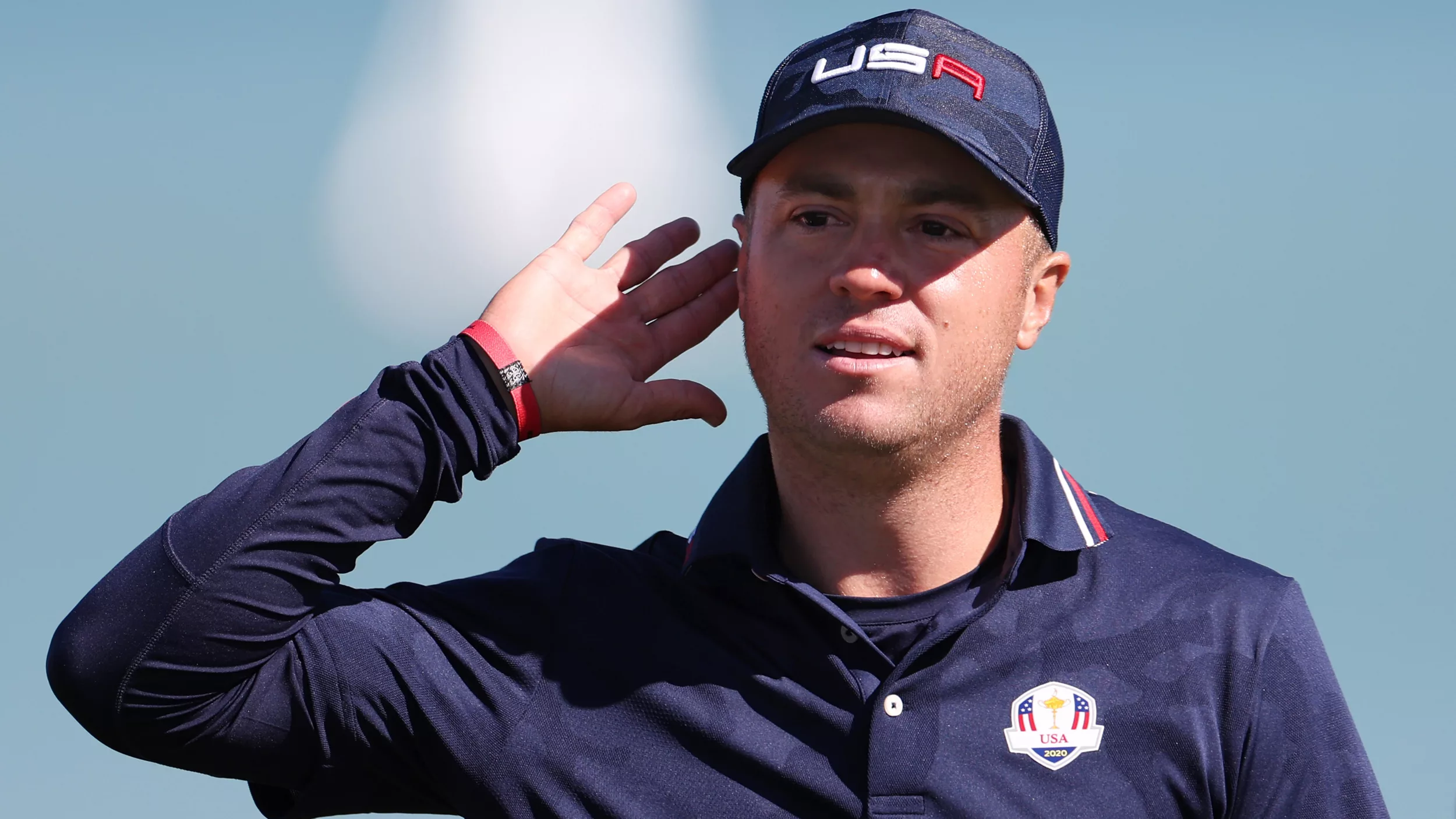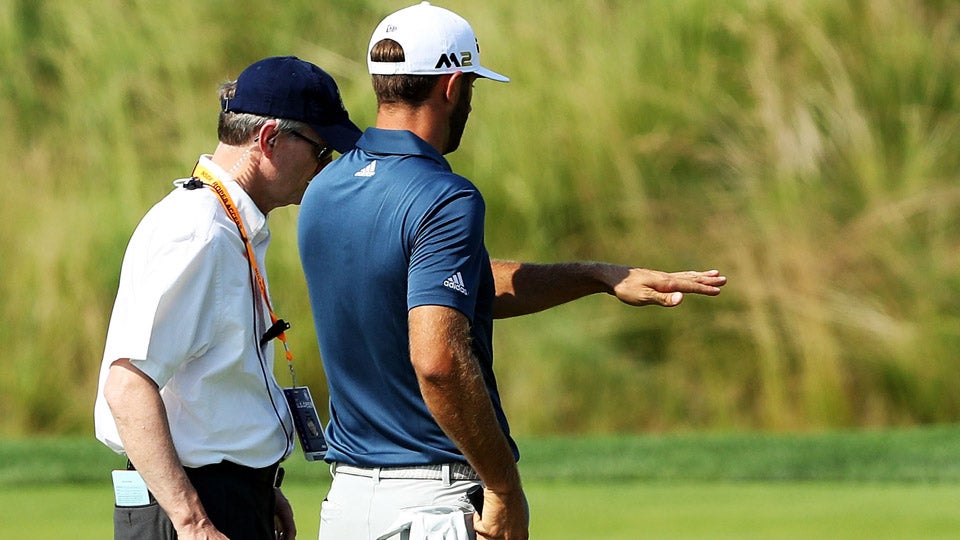News
The Mysterious Disappearance of JT from the Ryder Cup

In case you haven’t heard, Justin Thomas is experiencing something of a dry spell right now. His position in the Official World Golf Rankings has plummeted from eighth to twenty-fourth since the start of 2023. JT is 77th in the FedEx Cup rankings with two weeks left in the regular season. Since the playoffs are now limited to the best 70 players, he would be eliminated from contention if they began today. He hopes to enhance his standing by doing well at the 3M Open this week. This is an unfathomable fall for a player who, at his best, ranks in the top five or so of his sport. Both a spot on the U.S. Ryder Cup Team and the FedEx Cup Playoffs are in jeopardy. On the American points list, where the top six players are guaranteed spots after the BMW Championship, he is now ranked 14th. If he doesn’t make the postseason, he’ll fall farther in the standings.
THE NUMBERS SPEAK FOR THEMSELVES…
What is Justin Thomas’ Ryder Cup record?
Post the 2021 event, Justin Thomas has, so far, earned 6.5 points from 9 matches: a 72% win rate.
More about Justin Thomas’ Ryder Cup record.
A serious competitor, we can look forward to many more Ryder Cup appearances by Justin Thomas:
Singles: 2 wins, no losses from 2 matches (100% win rate).
Fourball: 2 wins, no losses and a half from 3 matches (83% win rate)
Foursomes: 2 win, 2 losses from 4 matches (50% win rate).
Thomas has emerged as a key player for the U.S. squad over the past few years. His play has been superb, to be sure, but his theatrics have served to his advantage by frustrating the Europeans. Thomas is playing in both the 3M Open this week and the Wyndham Championship the following week due to his perilous position in the FedEx Cup standings and the Ryder Cup points list. Thomas can improve his chances of being selected as a captain of his team or of cracking the top 70 and making the playoffs with consistent play.
If you had told someone in May of 2022 that Justin Thomas wouldn’t be playing in the Ryder Cup because of his terrible play, they would have laughed you out of the room. He had recently won the PGA Championship at Southern Hills and appeared to be on track for more success at the major championship level. Since his PGA victory, Thomas has played in 24 tournaments with a full field, but he has only managed four top-10 performances. This season, he ranks 43rd in Strokes Gained: Total, down from 6th the previous year. Thomas has gone from being an all-star to being a decent player. The primary reasons for this are a decline in his use of the driver and other irons.
Zach Johnson, as captain, is in a precarious position after this misstep. Thomas’s current performance level does not justify his inclusion in the Ryder Cup. However, he is well-liked by the other American superstars and is one of the biggest names in the player pool. If Thomas keeps his current level of performance and Johnson still selects him, it will be seen as a political rather than a merit-based decision. This selection process is typical of previous editions and tends to favor players who are popular rather than those who play well. It might spark a revolt among players who, together, have stronger credentials from the past two seasons.
Truth be told, most golfers consider making the Ryder Cup squad a career highlight. Similar to being selected for an all-star game in other sports, this honor recognizes sustained achievement over a number of seasons. Ryder Cups serve as a yardstick by which to compare the careers of American and European greats of yesteryear. An incredible feat, Phil Mickelson played in every Ryder Cup from 1995-2018. Also, I think it would look great on Justin Thomas’s resume if he had participated in seven or eight straight Ryder Cups. He is currently counting to two. There are only three spots left, and Thomas is competing with Keegan Bradley (2012, 2014) for one of them. Bradley’s remarkable longevity in the industry would be highlighted if he were to make the 2023 squad.
Ryder Cup selections not only add prestige to a player’s resume but also pay well. Players that make the Ryder Cup team have a better chance of receiving large sums of money via the PGA Tour’s new Player Incentive Program (PIP), which rewards players who bring in the most attention and media coverage for the sport. If Justin Thomas makes the team, he could make seven figures between sponsor bonuses and potential player incentive payments. Of course, it’s also very valuable to the stragglers with whom Thomas is vying for a spot in the Ryder Cup. A berth on the Ryder Cup Team would be a huge boost in exposure for golfers like Cameron Young, Sam Burns, and others. Players are not compensated for their participation in the Ryder Cup, yet doing so still provides a significant financial benefit. It also lays the stage for complaints if Thomas falters in the final stretch but still makes the team.
Thomas has a good argument, though. If he performs well at the 3M and Wyndham, makes the playoffs and maintains his form during the postseason events, he will likely be selected. But if he struggles and doesn’t improve his current FedEx Cup standing of 77th to make the playoffs, that will be a huge problem for Zach Johnson. Oh yeah, and who can forget this moment in France when he and Daniel Berger Shotgunned Beers in front of screeming American fans… I for one loved it!
The PGA, the DP World Tour, the TV partners, the advertisers, and anyone else with a financial stake in the Ryder Cup would love to have Justin Thomas on their squad. He has the capacity to attract a wider, non-golfing audience to a tournament than almost any other golfer. For the first time in 30 years, the Ryder Cup will be played on European territory, and Johnson must balance the expectations of others with his responsibility to assemble the greatest possible American squad. If JT keeps playing poorly, it will be difficult to argue that he is your best bet for victory. A legacy selection would also certainly spark controversy and disagreement among fans and players who were overlooked for the spot. There has been a change in the U.S. national team’s identity in recent years, from one based on special treatment to one based on meritocracy. Unless Thomas significantly raises his game, selecting him would be a throwback to the good ol’ boys ethos of the past few decades.
The political pressure on Zach Johnson has been increased by the announcement this week that Justin Thomas would participate in Johnson’s fundraising outing in Des Moines. There would be intense pressure from players and the media if Thomas made the team without showing significant improvement in the next two weeks.
The aforementioned modification to the FedEx Cup structure adds yet another layer. The PGA Tour has reduced the number of qualifying spots for the playoffs from 125 to 70 this season. With a decent week or two of performance in the past, JT’s chances of advancing were never in doubt, and he could realistically play in numerous playoff events. Switching to a top-70 format was a brilliant change that has worked out beautifully thus far. Thomas probably wouldn’t have played the 3M if he had already clinched a playoff spot. Fans in Minnesota can finally witness one of the sport’s most recognizable athletes compete for actual money. The Thomas case has given this week’s news a dramatic edge it otherwise wouldn’t have had. Intensifying competition for playoff spots has woken up a period of the season that is often quiet. The events and the audience members both benefit from that. Personally, I hope he has a great game. With Justin Thomas as a competitor, the Ryder Cup will be more exciting than if he were an assistant captain

Check back often to stay informed on everything happening on and off the course.
- The year’s best-selling fairway wood offers distance and forgiveness
- This 1 swing drill can help you find more fairways | 5 key tips for 2026
- What will Tiger Woods’ next 50 years look like? I asked a psychic
- New Year’s golf resolutions you might actually achieve
- Our most-read power tip of 2025 featured this simple weight-shift drill
- Stories of the Year in golf — from equipment to movies to Rory McIlroy’s Masters
- LIV Golf alters format again; OWGR adjusts 54-hole policy
- $5 green fees?! How young golfers can enjoy one of game’s best deals
- This pristine public 9-holer in New York’s first capital topped my 2025 list
- The year’s most-read rules question involved where to stand when someone’s putting
- Tiger Woods has lived his first two acts. His third act is a work in progress
- My 5 gear takeaways I learned in 2025 and how they can help you in 2026
- The clever tip Tiger learned at age 3 that helped him sink pressure putts
- Making this 1 practice tweak can add tons of speed to your swing | 5 key tips for 2026
- Rory McIlroy, Nelly Korda and song writing: 25 wishes for the holidays
News
The 6 Most Ridiculous Rules in Golf

Let’s get these changed ASAP huh Fellas?
Remember Dustin Johnson pleading to a rules official during the final round of the 2016 U.S. Open. I had his back and most of the world did too.
They say you can’t fix stupid, but you are able to complain about it and hopefully get it changed. Golf, this game we love, there is plenty of senselessness to go around. Witness the Rules of Golf, an encyclopedic catalog of do’s and don’ts that often fall beyond the bounds of reality
For argument’s sake, here’s our take on six of the dumbest rules in the most beloved sport on the planet. OK, maybe I am biased, but the game is pretty old and may need a little botox here and there. Just Sayin’

1. The Dreaded “DJ Rule
In the official ledger, it’s Rule 18-2. But ever since the 2016 U.S. Open, it’s more widely recognized as that *&%$!!!-ing Dustin Johnson Rule. You know, that nonsensical one under which the eventual tournament winner was slapped with a one-shot penalty for supposedly causing his ball to move a nano-millimeter on the 5th green. Never mind that he clearly didn’t intend to set the ball in motion, or that the micro-movement gave him no discernible advantage. The punishment stood. But we shouldn’t have to stand for it in the future. How about this? Next time around, no harm, no foul. Move the ball back, end of story!

2. No Relief from Sand-Filled Divots – In the fairway?
Let’s see if we understand correctly: if we spray a tee shot off-line and our ball winds up in the ground under repair zone, we’re entitled to relief. But if we smoke one down the middle and it settles in a sand-filled crater left behind by another golfer, we’re doomed to play it as it lies. That ground we landed in happened to be damaged. Someone tried to repair it. Sounds to us like… the ground is under repair. Now Im no genius, but are you following me here?
2. The “DROP”
You’d think that hitting a shot into a hazard would be punishment enough. But you’d be wrong. Under the Rules of Golf, the dogged victim then has to go through the tedious ritual known as the drop, which brings other potential rules infractions into play. If the dropped ball moves closer to the hole (as it so often does) twice, the player gets to place it. So why not just allow placement from the start? It would spare the player undue pain, and save the rest of us a lot of time.
3. Stroke & Distance
In American jurisprudence, it’s known as double jeopardy, a procedural defense that protects us from being prosecuted twice for the same crime. Sounds reasonable, right? No such safeguard exists for a golfer who bangs a ball into oblivion, only to be slapped with a stroke penalty on top of loss of distance. That’s two punishments for one misdeed, and it’s unjust by any measure. We, the people, call for a one-stroke penalty and lateral relief. Motion Carries!
4. Sprinkler Head in Your Putting Line
Your approach shot lands pin high, just on the collar, and a straightforward putt awaits, with just one problem: a sprinkler head lies in your putting line. Common sense suggests that you should get relief, no closer to the hole; a sprinkler head, after all, is a man-made impediment. But common sense apparently has no place here. Your only hope is that the course you’re playing has a local rule that allows line-of-play relief from immovable obstructions within two club lengths of the green, which, let’s be reasonable here, should really be the rule that governs all play.
5. Five Minutes for a Lost Ball – Really?
That lax allowance dates back to a bygone era, when life moved at a pastoral pace and golfers had the luxury of lollygagging. This is the modern age. Chop, chop, time’s a-wasting. We’ve got cat videos to watch and vapid tweets to send. The game needs to adapt. And besides, if you can’t find that errant ball in two minutes, you probably don’t want to in the first place. It will be under a rock or in a bush but with just enough clearance that those 9 deadly words are uttered “I think I can get a club on it”
6. Cant move a ball from a footprint in a bunker – This one Grinds my Gears
It might make sense on Tour, where players all have caddies and the grounds are as well-groomed as the gardens of Versailles. But many of the courses we mortals play are under-tended and trod upon by etiquette-flouting chops who don’t even attempt to rake up their mess, creating hazards within hazards. The more sensible alternative: if your ball lands in a footprint in a bunker, move it and place it elsewhere in the sand. Done, End of rant. You may go about your business.
Blog
When Golf Meets Supercars: The World Series of Golf Takes Over Skip Barber’s Mexico Resort
World Series of Golf partners with Skip Barber Racing for a two-year luxury sports series at Gran Reserva, Mexico – where championship golf meets supercars starting April 2026.

Picture this. You’re standing on the 18th green at Gran Reserva, Mexico, finishing a round of championship golf with the World Series of Golf’s signature betting format still buzzing in your veins. The sun’s dropping low. Your heart’s still racing from that final putt.
And tomorrow? You’re driving a McLaren on Skip Barber’s brand-new racetrack.
Two Sports, One Unforgettable Weekend
The World Series of Golf just announced something we’ve never seen before. A two-year partnership with Skip Barber Racing School that transforms their new Mexican resort into the ultimate luxury sports destination. It’s not just golf. It’s not just racing. It’s both, wrapped into an experience that redefines what a sporting weekend can be.
Starting in April 2026, Gran Reserva becomes ground zero for a completely new kind of event.
Year One: The Foundation
The first year lays the groundwork. You’ll compete in the World Series of Golf championship using their patented tournament format – the one that adds poker-style betting mechanics to traditional stroke play and turns every hole into a strategic showdown. High stakes. Real tension. Golf the way it was meant to be played.
But here’s where it gets interesting. While you’re playing, Skip Barber’s building their racetrack right there on the property. You’ll see construction crews working on what will become one of North America’s most anticipated racing circuits. State-of-the-art simulators give you a taste of what’s coming, letting you experience the thrill of motorsports between rounds.
VIP receptions. Celebrity appearances. Curated culinary showcases that match the caliber of the competition. It’s an invitation-only event designed for people who expect excellence and aren’t willing to settle for anything less.
Year Two: The Payoff
Then 2027 hits. The track is finished. And suddenly you’re not just imagining what it’s like to drive a supercar at speed – you’re actually doing it.
McLaren. Ferrari. Mercedes. Lamborghini. Take your pick and put it through its paces on a circuit designed by people who’ve spent over 50 years teaching professional racers how to extract every ounce of performance from a machine. Skip Barber doesn’t mess around when it comes to motorsports education, and this track reflects that pedigree.

You’ll stay in exclusive luxury accommodations at Gran Reserva, network with athletes and industry leaders, and experience both golf and racing at the highest possible level. All in one place. All in one unforgettable weekend.
Why This Matters
Michael Berg, CFO of Skip Barber Racing School, called it perfectly: “Guests will see the racetrack under construction during our first event and then drive world-class vehicles on it the following year.”
That’s the hook. You’re not just attending an event. You’re watching it evolve. You’re part of the story from day one, and by year two, you’re living the payoff.
Robert Davidman, CEO of the World Series of Golf, added this: “This partnership unites golf and motorsports in an elevated format that caters to international fans seeking competition, luxury, and adventure.”
Competition. Luxury. Adventure. Three words that sum up what makes this special.
Why Sponsors Are Paying Attention
Here’s what makes this different from every other golf tournament trying to get your marketing dollars.
The World Series of Golf’s patent-protected format keeps spectators glued to every shot. Shot-by-shot wagering. Antes that double every three holes. Strategic decisions that matter as much as swing mechanics. It’s golf designed for television, and television designed to keep people watching.
Add Skip Barber Racing to the mix and you’ve got something networks actually want to cover. Over 40 hours of TV coverage. More than 15 million media impressions. Five million-plus social media reach. This isn’t a local tournament hoping for some local news pickup. This is a broadcast-ready event with an audience that’s already paying attention.
The demographics tell the rest of the story. You’re reaching affluent golf enthusiasts who also appreciate high-performance automobiles. International travelers who think nothing of flying to Mexico for a weekend of luxury sports. Decision-makers and industry leaders who network at VIP receptions and actually have the authority to sign deals on the spot.
Title sponsorship gets you naming rights, eight playing positions, and premium TV exposure throughout the broadcast. But even smaller packages deliver value. Hole sponsors get exclusive on-course branding and social media mentions for ten grand. Golf cart wraps guarantee TV and photo exposure because every shot of the tournament includes your brand.
The opportunities are limited by design. Only 18 hole sponsors. Three presenting sponsors. One title sponsor. Once they’re gone, they’re gone.
Want the details? Check out the full sponsorship packages at wsg.golf/sponsorship.
The Bottom Line
This isn’t your typical golf tournament. It’s not your standard track day either. It’s something entirely new – a two-year luxury sports series that gives you the best of both worlds and raises the bar for what a sporting experience can deliver.
Year one plants the seed. Year two delivers the harvest. And whether you’re attending as a player or partnering as a sponsor, you’ll be there for both.
For player inquiries, contact events@skipbarber.com. For sponsorship opportunities, reach out to sponsorship@wsg.golf. These events are strictly invitation-only, and opportunities won’t last long.
Golf and supercars. Mexico and motorsports. The World Series of Golf and Skip Barber Racing School.
This is going to be something special.
-

 Product Review6 years ago
Product Review6 years agoThe Perfect Practice Putting Mat Review by Jason Tenzer
-

 Blog4 years ago
Blog4 years agoLoophole Rule Offers PGA Tour Pros a Mulligan
-

 Blog4 years ago
Blog4 years ago2021 Buyer’s Guide: The Top 10 Value Golf Balls For Distance & Feel
-

 Blog5 years ago
Blog5 years agoGolf Marriage Counselor
-

 Blog6 years ago
Blog6 years ago9 Biggest Chokes Of The Past Decade
-

 Product Review6 years ago
Product Review6 years agoTHE ADJUSTABLE IRONS: WALKING STICKS GOLF CLUBS
-

 Blog4 years ago
Blog4 years agoWhat Your Golf Clubs Say About You
-

 Equipment6 years ago
Equipment6 years agoOHK Sports Interview by Jason Tenzer
















